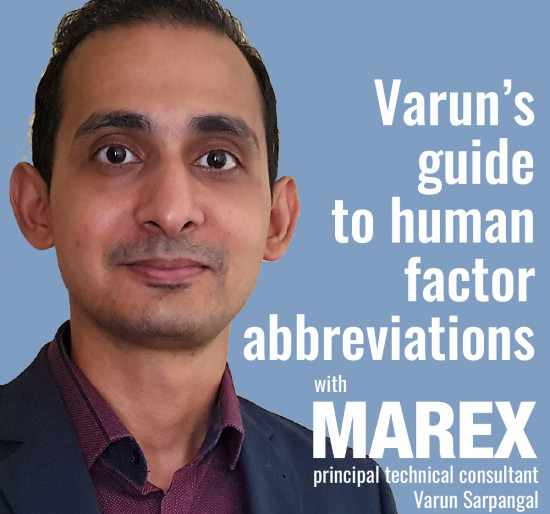Varun’s guide to human factors abbreviations
Aerospace, Renewables, Oil & gas, TransportSomething none of you knew you needed in your lives ... Varun’ guide to abbreviations in human factors!
Our principal technical consultant Varun Sarpangal guides you through the abbreviations used in human factors engineering

SCT: safety critical tasks
We start simple with SCT: safety critical tasks.
These aren’t just tasks where safety is critical. Safety critical tasks are tasks where human factors could cause, contribute to, or fail to reduce the effect of, a major accident.
Simple but important.
SCTA: Safety Critical Task Analysis
The next logical step is SCTA, or a Safety Critical Task Analysis.
Task analysis methods are used to understand what is being carried out, where hazards may be present, and where errors may occur.
Here’s how it works:
- identification the safety critical tasks
- rank the safety critical tasks by priority
- develop Hierarchical Task Analysis (more on that later) diagrams
- a Human Reliability Analysis
The SCTA process will identify significant human performance influencing factors (our PIFs) that are not in the optimal state for each safety critical task.
HTA: Hierarchical task analysis
Hierarchical task analysis (HTA): as the name suggests, it places a hierarchy on the order of tasks to be analysed. It breaks down a given human-performed activity into goals, tasks, and task steps.
The goal (the main task) is represented at the top level, and the sub goals (task steps) are represented at the next subordinate level. The task steps, in turn, may be broken into more detailed human actions (sub-steps) represented as nested boxes below each task step.
The method produces a tree structure, along with an additional output being a list of tasks outlining their sequencing in order to meet the overall task goal.
HRA: Human Reliability Analysis
Human Reliability Analysis (HRA): this is a process which uses a set of “guide words” similar to those used in a hardware HAZOP. The review team applies the guide words in a workshop setup to the lowest level of the developed hierarchical task analysis in order to identify the possible errors that could arise.
PIFs: Human Performance Influencing Factors
Human performance influencing factors (PIFs): examples of these are fatigue, distractions or a high cognitive workload due to a poorly designed human-machine interface
The best way to prevent human factors issues like these from leading to costly accidents is to proactively and pre-emptively carry out a systematic study to identify and understand the performance influencing factors, and make sure they are brought to their optimal states and maintained during ongoing operations.
WTTT: Walk-Through Talk-Through
Walk-through talk-through (WTTT): this is a method used to collect, record and analyse information about a task at a basic level to help understand task steps, identify likely error traps and discuss how the operator might typically deal with them.
Any team member can conduct and lead the WTTT and it must be completed in collaboration with the person(s) who usually conduct the operational task.
WAI v WAD: Work-As-Imagined versus Work-As-Done
Work-as-imagined versus work-as-done (WAI v WAD): in simple terms, WAI refers to how people think the work should be done whilst WAD is what people actually do to get the work done.
Work-as-imagined: what engineers, planners, advisers, managers or anyone else involved in design believe the work should be done, under ideal circumstances. It’s the work-as-imagined picture that determines how a process is set up, how people are trained and which controls need to be put in place.
Work-as-imagined is an idealistic view of the formal task that doesn’t consider how task performance is adjusted to match the constantly changing conditions of work and of the world. Work-as-imagined describes what should happen under normal working conditions.
Work-as-done: what people actually do to get the job done, taking into account the realities of the situation such as the equipment configuration, and ease of use of the procedure, and the time and resources they have.
Those who have to do the work may find they want to adjust the plans set out in the work-as-imagined in order to get their work done. If this happens without appropriate support, shortcuts may be taken or other habits adopted that can lead to errors.
However, if the difference between work-as-imagined and work-as-done is properly acknowledged and supported, then work can be adjusted safely and lead to reduced risk, increased reliability, and increased engagement.
We continue on our mission to demystify more terms and abbrevations: contain your excitement in the meantime.
And meanwhile, find out more about Varun and the rest of the team here.
#VarunInBrief #RisksManaged #humanfactors









